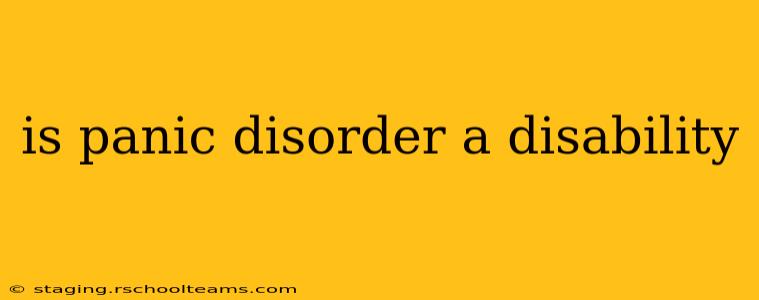Panic disorder, a debilitating anxiety disorder characterized by unexpected and recurring panic attacks, significantly impacts daily life for many sufferers. The question of whether it constitutes a disability is complex, depending heavily on the individual's experience and the specific legal definition applied. This article delves into the nuances of this issue, addressing common questions and offering clarity.
What is Panic Disorder?
Before discussing its classification as a disability, it's vital to understand panic disorder itself. It's not simply feeling anxious; it involves intense, sudden episodes of terror, often accompanied by physical symptoms like rapid heartbeat, shortness of breath, sweating, trembling, and chest pain. These attacks can be unpredictable, causing significant distress and fear of future occurrences. This fear can lead to avoidance behaviors, further limiting a person's ability to function in various aspects of life.
Can Panic Disorder Qualify for Disability Benefits? (US Context)
In the United States, the Social Security Administration (SSA) considers panic disorder a potentially disabling condition under the Social Security Disability Insurance (SSDI) and Supplemental Security Income (SSI) programs. However, simply having a diagnosis isn't enough. The SSA assesses whether the disorder significantly limits the individual's ability to perform "substantial gainful activity" (SGA). This assessment considers the severity of symptoms, the frequency of panic attacks, and the impact on daily functioning, including work-related tasks.
A thorough medical evaluation, including documentation from a qualified mental health professional, is crucial for a successful claim. This documentation should detail the severity and frequency of panic attacks, the impact on daily activities (such as concentration, social interaction, and maintaining personal care), and any limitations imposed on working.
What are the Criteria for Disability Due to Panic Disorder?
The criteria for disability vary depending on the specific program and country. In the US context, the SSA uses a five-step sequential evaluation process. The applicant must demonstrate that their panic disorder:
- Meets the duration requirement: The condition must have lasted or be expected to last for at least 12 months.
- Prevents substantial gainful activity: The panic disorder must significantly impair the individual's ability to work.
- Meets the severity requirements: The symptoms and their impact on functioning must meet the SSA's definition of "severe."
- Doesn't meet a listing: The individual's condition doesn't automatically qualify under a specific listing of impairments in the SSA's Blue Book.
- Prevents performing past relevant work: The individual must demonstrate that their panic disorder prevents them from performing their past work or any other type of work.
Meeting these criteria is essential for approval. Each case is assessed individually, considering the unique circumstances of the applicant.
How Does Panic Disorder Affect Daily Life and Employment?
Panic disorder significantly impacts various aspects of daily life. The unpredictable nature of attacks can lead to:
- Avoidance behaviors: Individuals may avoid places or situations that trigger attacks, limiting their social life and professional opportunities.
- Difficulties with concentration and memory: The constant anxiety and fear can make it challenging to focus on tasks and remember information.
- Sleep disturbances: Panic attacks often disrupt sleep, leading to fatigue and further impairing functioning.
- Social isolation: Fear of experiencing an attack in public may lead to social withdrawal.
- Relationship problems: The impact on daily life can strain relationships with family and friends.
These effects directly translate to challenges in maintaining employment. Consistent absences, reduced productivity, and difficulty performing job duties can lead to job loss or an inability to secure employment.
Is Panic Disorder Considered a Disability Under the Americans with Disabilities Act (ADA)?
Under the Americans with Disabilities Act (ADA), panic disorder can be considered a disability if it substantially limits one or more major life activities. This includes activities such as working, concentrating, thinking, sleeping, and interacting with others. The ADA protects individuals with disabilities from discrimination in employment, public services, and accommodations. Reasonable accommodations may be necessary to enable individuals with panic disorder to work or access services. These could include flexible work arrangements, stress reduction techniques, or access to mental health services.
How Can I Get Help for My Panic Disorder?
If you believe your panic disorder is impacting your ability to work or participate fully in society, seeking professional help is crucial. Mental health professionals can provide diagnosis, treatment options like therapy (cognitive behavioral therapy or CBT is particularly effective) and medication, and support in navigating the disability process.
This information is for general knowledge and should not be considered legal or medical advice. Consult with a qualified mental health professional and legal expert for personalized guidance.
